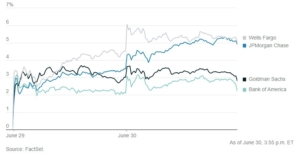Explaining Current Market Risks to Clients (And Prospects)
What’s in Today’s Report:
- How to Explain Risks in This Market to Clients/Prospects
- Mannheim Used Vehicle Value Index Takeaways (Chart)
Futures are slightly higher while most international markets rallied overnight thanks to news of more Chinese government support for the property sector and steady EU inflation data.
German CPI met estimates of 0.3% m/m and 6.4% y/y in June, both unchanged from May, while the ZEW Survey was inline with expectations on the headline but Economic Sentiment deteriorated to -14.7 vs. (E) -10.2.
Domestically, the NFIB Small Business Optimism Index came in at 91.0 vs. (E) 89.8 in June which is helping bolster investor sentiment in the premarket.
There are no additional economic reports today and just one Fed speaker on the calendar: Bullard (9:00 a.m. ET) which will leave investors looking ahead to tomorrow’s critical CPI report.

